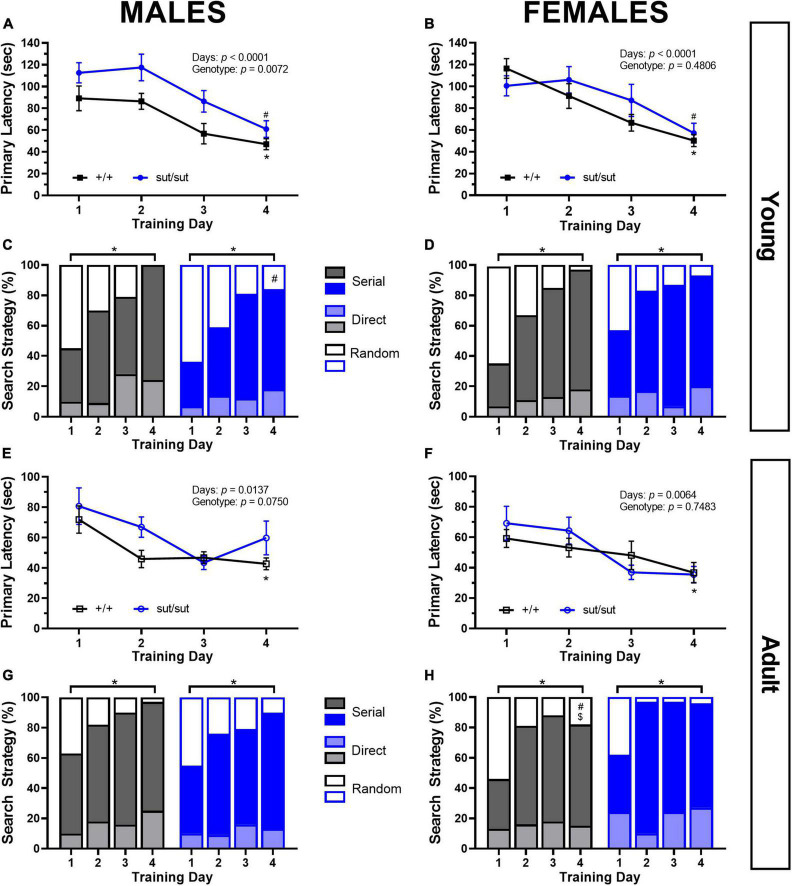FIGURE 8.
Barnes maze performance. Male or Female SLC7A11+/+ and SLC7A11sut/sut littermates were tested at 2 (young) [ +/+ , n = 11M:13F, black; sut/sut, n = 15M:10F, blue] and at 6 months (adult) [ +/+ , n = 13M:9F, black; sut/sut, n = 14M:10F, blue]. Spatial learning is measured as time to the escape chamber (i.e., primary latency) across days and graphed as mean ± SEM per each day. Data were analyzed via MMRM ANOVA followed by Dunnett’s multiple comparisons test. The percentage of direct [light gray or light blue], serial [gray or blue] and random [white with black or blue borders] strategies used per each training days are graphed. Differences in strategy used between groups or days were determined by Fisher’s exact test. No within genotype sex differences were found. (A) Young sut/sut male mice took longer to find the escape chamber as compared to +/+ , but both genotypes improved their performance over time: F(1, 24) = 8.628, p = 0.0072, genotype; F(2.206, 50.06) = 15.13, p < 0.0001, training days; F(3, 68) = 0.4644, p = 0.7081, interaction, performing significantly better on the last day (d1 vs d4: *p = 0.0406 for +/+ , #p = 0.0031 for sut/sut). (B) Young female mice improved their performance on the maze over time: F(2.669, 56.06) = 15.58, p < 0.0001, training days; F(1, 21) = 0.51578, p = 0.4806, genotype; F(3, 63) = 1.690, p = 0.1782, interaction, and performed better on the last day (d1 vs d4: *p < 0.0001 for +/+ , #p = 0.0090 for sut/sut). (C) Young male mice adopted more effective (direct + serial) search strategy with training regardless of genotype (*d1 vs d4: p < 0.0001 for both +/+ and sut/sut). However, while +/+ male mice fully abandoned the use of a random strategy by day 4, sut/sut mice did not (#p = 0.0177 for d4). (D) Young female mice adopted more effective search strategies (direct + serial) across training days regardless of genotype (*d1 vs d4: p < 0.0001 for +/+ ; p = 0.0204 sut/sut). No genotype differences in strategy utilization by day 4 was found in female mice (p = 0.5757). (E) A main effect of training was present in adult male mice: F(1.613, 37.64) = 5.313, p = 0.0137, training days; F(1, 25) = 3.452, p = 0.0750, genotype; F(3, 70) = 0.7608, p = 0.5198 interaction. Post hoc analyses: adult +/+ mice improved their performance (*d1 vs d4: p = 0.0270) whereas adult sut/sut mice did not (d1 vs d4: p = 0.6446). Escape latency improved with age regardless of genotype: +/+ : F(1, 12) = 9.204, p = 0.0104 for age; sut/sut: F(1,14) = 19.23, p = 0.0006 for age. (F) A main effect of training was present in adult females: F(2.728, 50.01) = 4.806, p = 0.0064, training days; F(1, 21) = 0.1057, p = 0.7483, genotype; F(3, 55) = 1.548, p = 0.2124, interaction]. Post hoc analyses: adult +/+ mice improved their performance (*d1 vs d4: p = 0.0431) whereas adult sut/sut mice did not (d1 vs d4: p = 0.1818). Escape latency improved with age regardless of genotype: +/+ : F(1, 12) = 28.72, p = 0.0002 for age; sut/sut: F(1,9) = 12.72, p = 0.0061 for age. (G) Male mice adopted more effective strategies (direct + serial) across training days regardless of genotype (*d1 vs d4: p = 0.0003 for +/+ ; p = 0.0008 sut/sut). (H) Female mice also adapted more effective strategies (direct + serial) across training days regardless of genotype (*d1 vs d4: p = 0.0030 for +/+ ; p = 0.0064 for sut/sut). Adult female +/+ mice persisted in their use of a random strategy as compared to young +/+ females (#d4: young vs adult: p = 0.0427) and as compared to adult +/+ male mice ($d4: p = 0.0427). No differences between adult +/+ and sut/sut female mice in their use of strategies was uncovered (d4: p = 0.1211).

